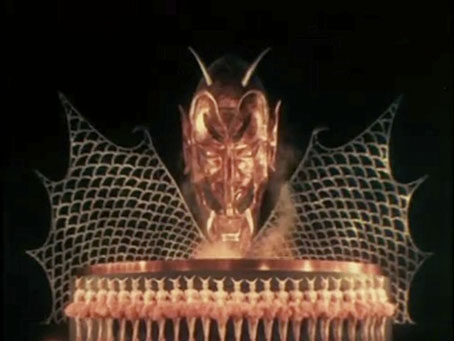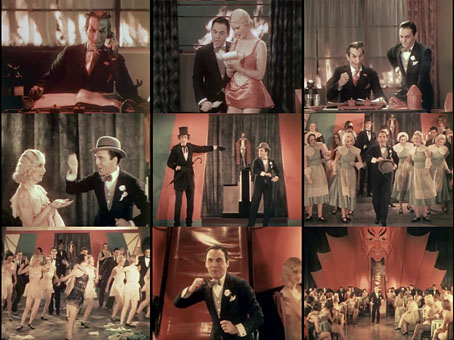
Halloween approaches so here’s a frivolous piece of Hollywood Diablerie. The Devil’s Cabaret (1930) was one of several short films made to showcase dance sequences shot for The March of Time, an MGM musical abandoned by the studio halfway through production. The footage from the earlier film is a short ballet sequence featuring a company of horned ballerinas dancing around an enormous, leering Devil’s head. Dimitri Tiomkin composed the music. All the footage was shot using an early Technicolor process so the film is subtitled “A Colortone Novelty”.

The framing narrative is a sequence of short sketches that offend many of the principles the Hays Code was brought in to protect a few years later. An uncredited Charles Middleton (Ming the Merciless in the Flash Gordon films) is a CEO-like Satan urging his Vice President Howie Burns (geddit?) to counter Heaven’s successes by bringing more souls to Hades (the word “Hell” only gets used at the end but after 1934 it was banned from use altogether). Burns does this by interrupting a religious meeting on Earth with a jazzy dance sequence that turns into a strip show; everyone in the audience rushes to join the damned. Once in Hades the newcomers are treated to the March of Time ballet. Elsewhere there’s some laboured humour, references to the Wall Street Crash and Prohibition, and a fair amount of salacious dialogue. Films such as these are always a good reminder of how risqué Hollywood could be before everyone adopted the production code. (Thanks to Gabe for the tip!)
• The Devil’s Cabaret: part one | part two
Previously on { feuilleton }
• Chocolate devils
• Harry Lachman’s Inferno

Ha
According to IMDB Peter Cook and Dudley Moore’s 1967 Bedazzled references this because the Devil is the owner of a raucous nightclub
http://www.t3licensing.com/license/clip/48050358_3800.do
Hmm, I don’t remember that in the film. Cook was a nightclub owner himself in the mid-60s with his satire club in Soho; I’d have thought that was as likely a reference.
some good still from Bedazzled here http://markbourne.blogspot.com.au/2011/09/bedazzled-1967-giving-devil-his-due.html
“… the devil makes his God-appointed, workaday living as the proprietor of a grubby London nightclub and business office staffed by the Seven Deadly Sins. “
I ought to get a DVD at some point, it’s a while since I watched it. I had to give it a rest a few years ago, it was getting like the Monty Python films: seen them so many times you can karaoke along with them.
The DVD has a good interview with Barry Humphries who has a small cameo in the film :-)
The film is nice but not enough of Charles Middleton!! It’s too bad they lost their nerve at the end and didn’t close with a wild savage orgy and then with the whole cast being tossed into a lake of fire and brimstone-now that’s entertainment.
The film “Angel on my Shoulder” 1946 with the great Paul Muni and Claude Rains is worth seeing if you missed it. The opening scenes in Hell with the condemned stoking the furnaces and the pervasive gloom are some of the best visions of the inferno on film. The story of redemption and the Devil’s plans being foiled by the “good heart” of a criminal is okay. At least the fate of the main protagonist is logical and not some “Hollywood” ending.
Hi Richard. I always enjoy Hollywood’s conceptions of Hell, kitsch or not, but Angel on My Shoulder isn’t one I recall seeing. Harry Lachman’s Dante’s Inferno is still my favourite for being such a stunning recreation of the Doré illustrations. I don’t have a link to hand but I came across a blog post recently that looks at three of the early Inferno films ending with the Lachman.
John
I believe I did see the movie “Dante’s Inferno” with the scenes inspired by Dore. They were wonderful if a little chaste in the display of graphic nudity.
I was thinking more of a modern version of Hell. I assume that Satan renovated the place to accommodate the overwhelming demand that the 20th Century has placed on his realm.
Obviously, there are many contemporary decent in to Hell. Two wonderful books that come to mind and update Dante are: “Inferno: by Larry Niven and Jerry Pournelle and “My Visit to Hell” by Paul Thigpen. Both have Virgil like guides.
Try to see the movie “Angel on my Shoulder” for the opening scenes. The images could be drawn from the sub-basement of any of today’s large cooperate headquarters
Have you seen “What Dreams may Come?” The movie inspired by the Richard Matheson novel. It has a wonderful vision of Hell at the end… a desolate landscape filled with shipwrecks. Robin Williams [the main character] finds his suicide wife living in a tiny house in an upside-down cathedral. The stunning visuals in the movie save it from being sentimental. The vision of Hell in the book, however, is much darker and disturbing. A place of total darkness.
A post on the depictions of Hell in the movies might be an interesting vehicle for you.
Yes, I’ve read Niven & Pournelle’s Inferno, oddly enough I was telling someone about it recently. I enjoyed it much more than their other books although I was a teenager at the time. I’m not sure what I’d think of it today.
I’ve still not seen the Matheson film despite having a lot of time for Matheson and being intrigued by the idea. I’m afraid I’m in the minority of never having liked Robin Williams very much. He was okay in small doses but I always found him insufferable in bigger roles, especially ones where he’s shouting all the time. I know the film isn’t a comedy but I was never very convinced by him as a straight actor either. Orson Welles once said that comics make good actors because getting people to laugh at anything is a difficult business so you have to be very good to do it. That’s true with many comics but I never thought so in Williams’ case.
Hell in cinema is a big subject to tackle in a blog post, I wouldn’t really have the time to do the subject justice.